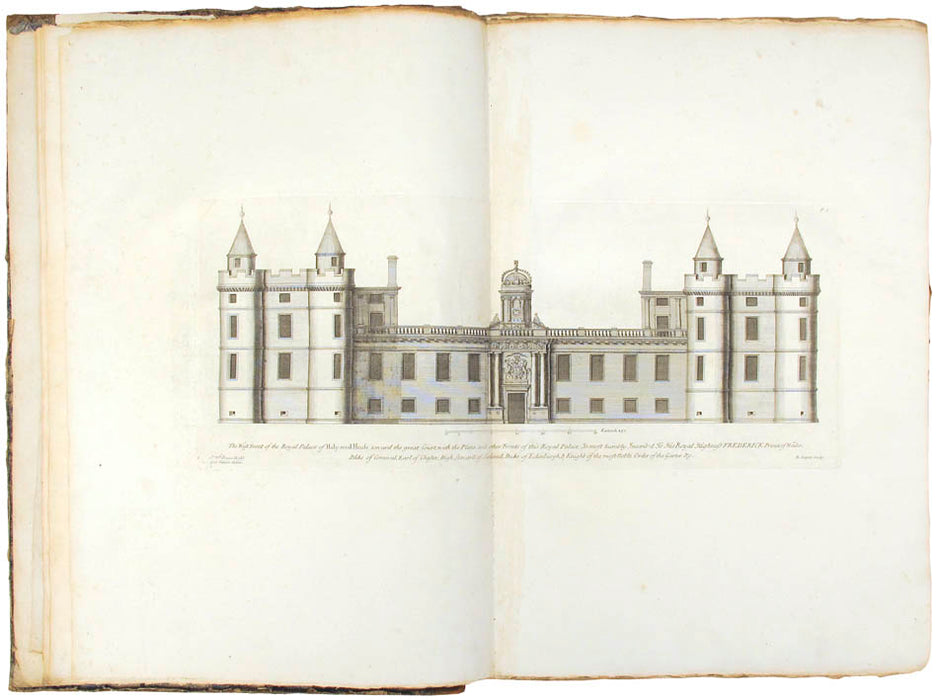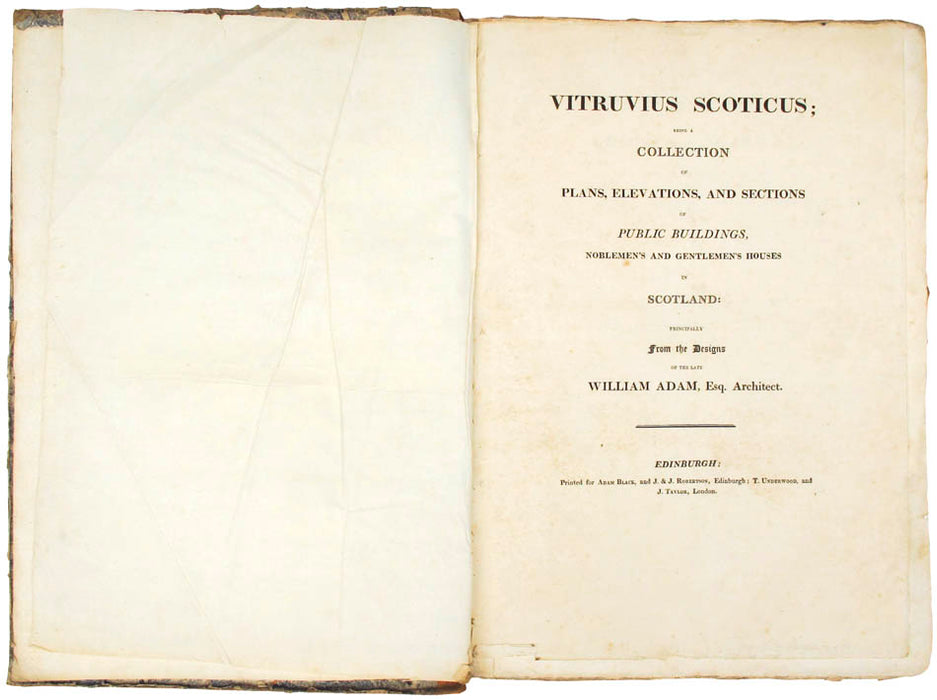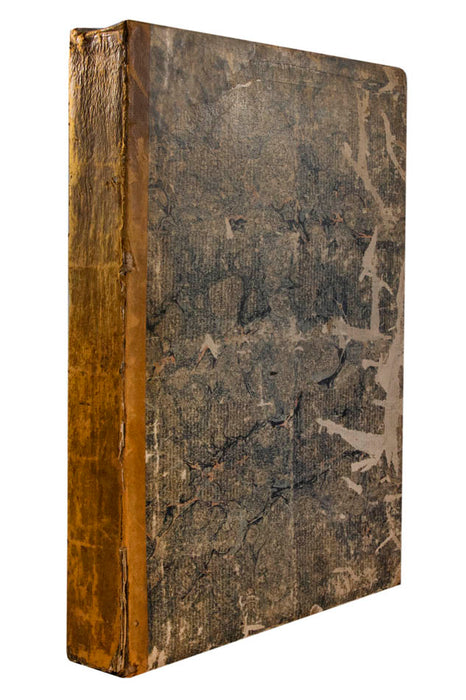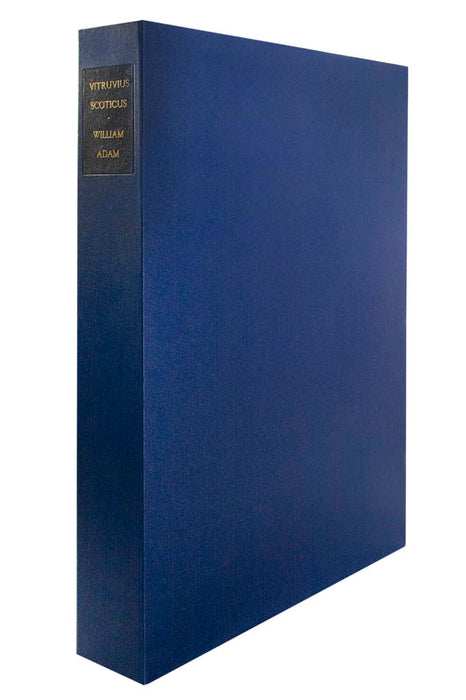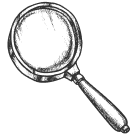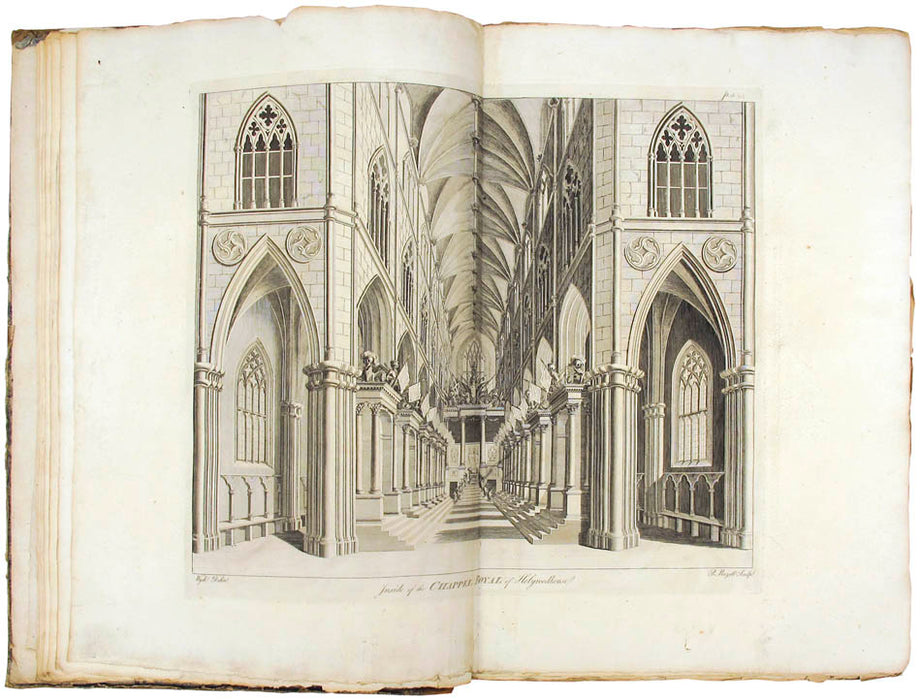
Vitruvius Scoticus;
Being a Collection of Plans, Elevations and Sections of Public Buildings, Noblemen's and Gentlemen's Houses, Principally in Scotland: Principally from the Designs of the Late William Adam, Esq. Architect.
Edinburgh, Adam and Charles Black, n.d. (c.1730 - 1740 / 1762 / 1811).
What was to become William Adam's (1689 - 1748) magisterially-intentioned yet still mysterious Vitruvius Scoticus was first mentioned in a letter in 1726 and by late 1727 Adam was issuing subscription receipts for a book of 'My Designs for Buildings &c. in 150 Plates'. Initially proposed as a book in the manner of James Gibbs' Book of Architecture ('the first book in England to be devoted entirely to the designs of a living architect'), Adam intended clearly to rival Gibbs, to publicise his own work and to seek promotion and patronage from the new King, George II. By 1733, Adam had found an Edinburgh-based engraver suitable for the task (and one who may have shouldered some of the cost) in Richard Cooper, a student of John 'Friar' Pine and 'an acknowledged teacher and connoisseur of the fine arts'. Indeed, it may have been Cooper who was the first to suggest a generalisation of the work and the assumption of a distinct Scottish character with the new title Vitruvius Scoticus. Cooper worked solely from the limited resource of Adam's own designs and under the stricture that there would be no theoretical work in the publication and was therefore limited and slow in what he was able to achieve. It is clear that Cooper's engravings were finished by the early 1740s but the reasons the work was then abandoned - not for the last time - are rather less so.
It has been suggested that William Adam hesitated to publish for a number of reasons: financial pressure and the inherent costs of paper, printing and publication; the curtailment of opportunities for promotion and patronage; a conflict of copyright; the 1745 Jacobite rising; Adam's advancing age; and, finally, the possibility of unflattering comparisons to Colen Campbell's Vitruvius Britannicus. At William's death in 1748, his son John revised the project, adding additional plates (including several taken from designs by his brothers Robert and James) and it seemed, at least briefly, that the book would finally appear. At the time of the crash of the Fairholme brothers' bank in 1764 all was in readiness but the added financial burden on all of the brothers led John to sell the publishing rights to the London-based Andrew Millar and his partner Thomas Cadell; they issued subscription proposals in 1766. The agreement between John and the Londoners stipulated that of the existing sheets, adequate for 950 copies, they would require material for 750 and would allow the remainder to be retained by John for the existing subscribers. No copies were issued - it has been suggested that the reason was related to copyright although Robert and James Adam's opposition to a family association with 'outmoded taste' has been offered as more compelling - and on Millar's retirement in 1767 the sheets were in storage where they remained for 40 years.
In 1804, Thomas Cadell's son wrote to John Adam's son (another William) that he was no longer able to store the sheets but that a scrap-paper merchant had offered £100 for them. Cadell's advice was to accept and it has been assumed subsequently that William did not: a story likely to be apocryphal states that the unused sheets were returned to Edinburgh and stored in a garret at the Royal Infirmary. It seems rather likelier that William did accept the £100 for the paper and his ongoing negotiations to have Vitruvius Scoticus published in 1808 - 1810 involved only those sheets that remained in Scotland. That the eventual publisher, Adam Black, issued only 120 copies - a very small run for a book of more than limited appeal - supports very strongly the idea that the remaining sheets were pulped, an idea that the present copy, with the plates mounted on paper guards composed of sections of those same plates, corroborates. The final word on the mystery, and indeed, on the publication, belongs to Eileen Harris: 'It is ironical that to be commercially viable Vitruvius Scoticus, clearly the grandest of any architectural book published in Scotland, had to be sold in the end as a remainder … '.
'A resounding silence greeted Adam Black's announcement in the 'Edinburgh Weekly Chronicle' on 29 May 1811 that Vitruvius Scoticus was 'this day... completed in fifteen numbers'. Not only was William Adam's book [Vitruvius Scoticus] a century too late to have the bearing on Scottish architecture that its title promised; but, with no preface, explanatory text, or date of publication, it was silent also about itself, about the intentions of its author and, above all, about its complicatred past.' (Eileen Harris).
'The best and most jinxed of all the great 18th century British architectural books, William Adam's Vitruvius Scoticus was three times abandoned by successive generations of the Adam family before, finally in 1811, a young Edinburgh bookseller named Adam Black... published an edition of 'only 120 complete sets' hastily assembled from sheets printed nearly 50 years before... Ill-planned and muddled as the book was from its inception, it was a sad irony that Vitruvius Scoticus should end up as an obscure bookseller's remainder, totally unremarked upon at the time.
'We are left, therefore, with the virtually inescapable conclusion that a decision to publish Vitruvius Scoticus was definitely made, almost certainly in the early 1760s; that this decision was modified after the Fairholme crash to the extent that a London publisher agreed to buy the unsubscribed portion of the edition; and finally that the entire edition was deliberately withheld under the pretence that the work was undergoing revision by the engraver. Such an extraordinary fiasco might seem more far-fetched, were it not possible to detect, behind the scenes as it were, the influence of Robert and James Adam's rising star south of the border, where any publication connected with the family name might do more harm than good if it failed to evince the most advanced and novel taste of the day.' (BAL RIBA).
Of the utmost scarcity on the market, we can trace very few copies at auction or in institutions, and of those copies that can be traced, many appear to be incomplete; it is worth noting that Weinreb priced the example in his catalogue 2 ('Books and Drawings Before 1800') at £285 (in contrast the 1485 first edition of Alberti's De Re Aedificatoria was £845) and in catalogue 58 ('Fine Architectural Books, Part 2') in 1988 at £28,000.
First edition, folio (55 x 38.4 cm.), Printed title, two leaves with 'List of the Plans, &c.' in double columns listing 160 plates and 180 engraved plates numbered 1 - 160, including the unnumbered plates 71 and 148 and 20 'bis' plates with duplicate numbers, 20 double-page and one large folding plate on two sheets; plates mounted on paper tabs (from sheets of the same work?) throughout, the title and text leaves on wove paper with the watermark '1809', the plates on laid paper with the watermark 'LLAR' and a fleur-de-lys countermark and others as per RIBA, the sheets retaining deckle edges throughout. Sheet size: c. 53.4 x 35.6 cm; double-page plates: c. 53.4 x 71.2 cm; title and text: 51.8 x 35.8 cm. Contemporary calf-backed marbled paper boards, later protective box.
BAL RIBA 30 (incomplete); Millard 3 (disbound and mounted); Harris 8; Weinreb 2:4 & 58:1; see 'British Architectural Books and Writers 1556 - 1785' by Eileen Harris, Cambridge, 1990, pp. 94 - 104.
Provenance
Delivery
We offer secure and express delivery on all local and international orders of rare books, maps and prints placed through this website.






